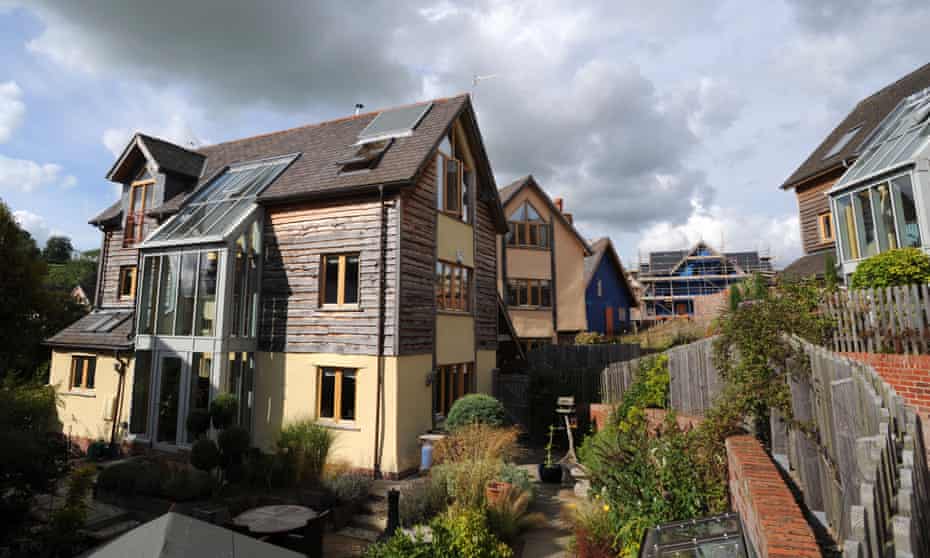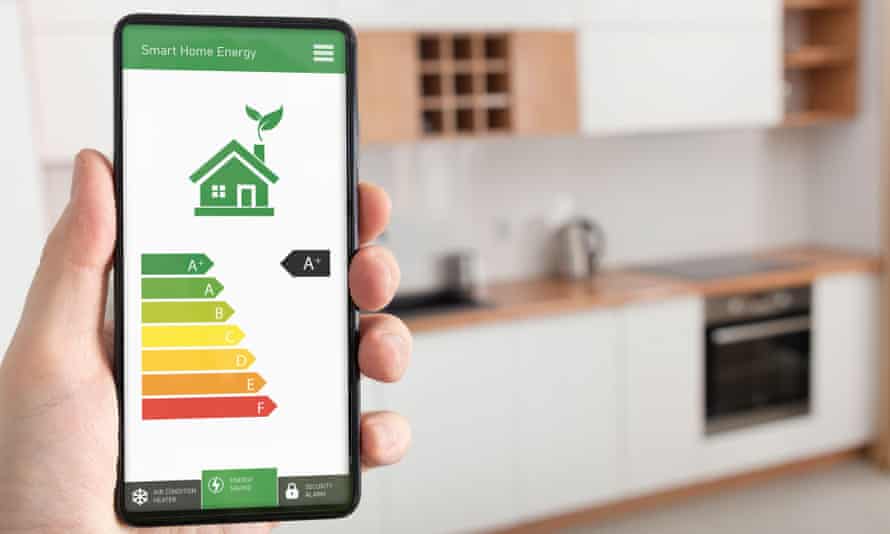Green mortgages: could your loan help make Britain greener?
Many of the UK’s biggest lenders now offer deals that reward buyers of energy efficient properties

Homes account for more than a fifth of the UK’s total CO2 emissions, which may help explain why the government and others believe green mortgages could be a gamechanger for moving to a sustainable future.
Although they have been around in one form or another for some time, environmentally friendly mortgages have yet to take off in a big way: a poll published this week found that 94% of brokers had never sold one.
However, Nick Mendes, a mortgage technical manager at the broker John Charcol, believes there will be “a huge tidal change” in the home loans market next year in terms of what is available.
For a long time it was pretty much only Ecology building society that was selling green mortgages but new products have been coming thick and fast lately.
Many of the UK’s biggest financial players now offer products, although the financial incentives for some deals are pretty negligible.
The basics
Broadly speaking, a green mortgage is one that rewards someone for buying or owning an energy-efficient home by offering them more favourable terms than come as standard. At the moment that typically means either getting a slightly lower interest rate, or cashback when you take out the mortgage, or both. Some deals are restricted to people buying a new-build property.
In addition, some lenders offer their existing mortgage customers additional borrowing at discounted rates to pay for green home improvements such as replacing draughty windows, upgrading an outdated heating system or adding solar panels.
Last month the government said it was keen to support the development of a competitive market in this area and was exploring plans to link mortgages to green home improvements by imposing targets for banks and building societies.
The background
At the heart of all of this are energy performance certificates (EPCs). An EPC is needed whenever a property is built, sold or rented. It gives the building an energy efficiency rating from A (most efficient) to G (least efficient).
Eligibility for many of the green mortgage deals is linked to the property’s EPC rating – for example, it might need to be A or B. However, properties that have not been sold or let out for a long time – of which there are several million – will not have one.

A big problem is the fact that the UK’s housing stock is notoriously old and leaky, and that particularly applies to some of the properties most desired by buyers, such as many Victorian and Edwardian terraces with their draughty but coveted original floorboards and sash windows. Last month the government said that in England in 2019, about 15m homes – 60% of the total – were below EPC band C. It has committed to upgrading “as many homes as possible” to achieve EPC band C by 2035 “where cost-effective, practical and affordable”.
However, Sarah Coles at the investment firm Hargreaves Lansdown says that while some homes can be upgraded at relatively little cost, other homeowners will find it prohibitively expensive.
A recent study by Nationwide building society found that the average bill for improving a property to reach a band C rating was about GBP8,100. Installing all of the energy improvement measures recommended for homes currently rated F or G would attract the biggest cost, it said: an estimated GBP25,800. You would enjoy savings on your energy costs but the financial payback could take many years.
Earlier this year the property website Rightmove said its research indicated that across England and Wales there were almost 1.7m homes currently rated between D and G that cannot be improved to reach a C rating.
What’s on offer now?
Currently, green mortgage borrowers tend to be rewarded with lower interest rates or cashback, according to Mark Harris, the chief executive of the mortgage broker SPF Private Clients.
Lenders offering the former include NatWest and Barclays. For example, NatWest offers a reduced rate on a two-year or a five-year fixed-rate mortgage, with cashback as well in some cases. To qualify, the property you are buying or remortgaging must have an EPC rating of A or B. With some of the deals the rate reductions are very small. For example, at the time of writing, NatWest was offering a standard two-year fix with a rate of 1.08% for up to 60% loan-to-value (LTV) that came with GBP150 cashback. The green version of this mortgage had a rate of 1.07%, with GBP250 cashback.
Some of the other NatWest deals did give you a bit more bang for your green buck: for those hoping to remortgage, it had a standard five-year fix up to 85% LTV at 2.58%, with no cashback. With the green version, you paid 2.49%, and it came with GBP350 cashback.
However, Harris says that while NatWest’s green mortgages may be a bit more keenly priced than the lender’s core range, there may be cheaper deals elsewhere. For example, while NatWest was offering a green two-year fix at 1.17%, HSBC had a non-green two-year fix at 1.04% (both were available up to 75% LTV and carried almost identical fees).
“Each lender has a slightly different approach to what constitutes a green property,” Harris says. With some, you need to be buying a new-build directly from the builder or developer. That is the case with Barclays, which requires an A or B EPC rating.
In April, Nationwide launched its Green Reward scheme, which gives those buying a home with one of its mortgages GBP250 cashback if it has a high B rating or GBP500 if the property is A-rated. So far, about 1,000 payments have been made through the scheme, with 90% of recipients getting GBP250.
Similarly, the Halifax offers GBP250 cashback where a property is rated A or B.
Meanwhile, some lenders such as Nationwide and TSB offer their existing mortgage customers a discounted “green additional borrowing” rate if they are carrying out energy-efficient home improvements.
Then there are specialist players such as the Ecology, offering mortgages for things such as self-build, renovation and conversion projects where energy efficiency is a central element.
When it comes to buy-to-let mortgages, things are moving faster. “Landlords have a greater incentive to be green due to new regulations being introduced from 2025, with rented property needing to have a rating of C or above. The change is to be phased in, starting with new tenancies of six months or more, followed by all tenancies from 2028,” Harris says.
The future
Over the coming months we will start to see dramatic changes in terms of the mortgage market, reckons John Charcol’s Mendes. We could start to see fixed-rate deals emerge where, for example, the rate you pay within the fixed period comes down if you carry out certain green home improvements.
Mendes believes there could also be changes around mortgage affordability, where someone with an energy-efficient property may be able to borrow more on the basis that their energy bills and costs will be lower.
